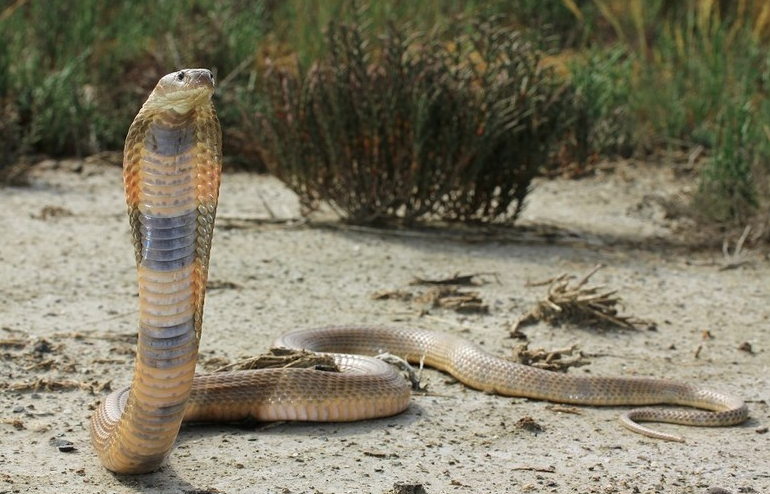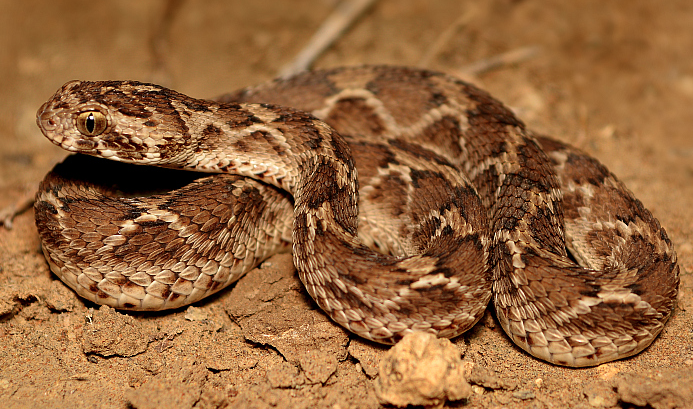- Recent research shows that snake venom from different parts of the country have different characteristics. Thus the process of making ASV using venom collected from one part of the country is a flawed process.
- Polyvalent ASVs that are good for the bite of the top four snakes – cobra, Russell’s viper, krait and saw-scaled viper – are losing their efficacy. There is need to produce monovalent ASVs that are good for the bite of one species of snake.
- Though monovalent ASVs are more effective, managing snakebite treatment with them is more difficult for local hospitals.
- There is a shortage of ASVs in the country, with only one government facility producing it. The remaining is met from private suppliers.
Mari, a middle-aged man belonging to the Irula tribe of Tamil Nadu, is equally comfortable in handling poisonous snakes and rattling off about their dangers in broken English to a scared yet, excited group of tourists. He deftly picks up a snake with one hand while telling the crowds how snakes do not have it in them to take revenge, even as the hooded cobra hisses and tries to strike at him.
“If that’s ever the case, my friends and I would have been dead a long back,” he tells the crowd as they drop their guard seeing Mari’s confidence. “While snakes are always keeping an eye on you if they think you are a danger, they attack only when you go too close to them. Their first attempt is to just slither away,” he added.

Mari was not only trying to break myths surrounding snakes but is also saving thousands of lives across the country by extracting venom from snakes. He works at the Irula Snake Catchers’ Industrial Cooperative Society at the Madras Crocodile Bank at Vadanemmeli village in the outskirts of Chennai. It is one of the two centres in the country where snake venom is collected to be supplied to the laboratories, institutes and private players involved with the manufacture of anti snake venom (ASV – also known as snake antivenom).
While Mari’s job may be noble and dangerous, experts say that it is neither efficient nor sufficient. They say the there is not only an urgent need to ramp up production of ASV but also decentralise the source of venoms to make them more potent.
Snake venom has local variations
“ASVs made from venom extracted from snakes in Chennai will only be potent in the southern region. It potency drops dramatically as you move further,” said Jaideep Menon, a member of Toxins and Venom Committee established by the Department of Biotechnology (DBT) and the Indian Council of Medical Research (ICMR). Menon is a cardiologist and professor at the Sri Narayana Institute of Medical Sciences, at Chalakka in Kerala. “We need to extract venom from where it is required for treatment for maximum potency,” he added.
The committee has now called for research proposals to move to develop more efficient ASVs. This means shifting from polyvalent’ to ‘monovalent’ ASVs. All ASVs produced in the country are from a combination of the ‘big four’ venom: common cobra, saw-scaled viper, Russell’s viper and common krait. Since they have venom from four snakes, they are called polyvalent venoms. Ideally, the ASV should be made from a single species of snake and be used for treatment for bites from that particular snake alone.

The venom for the ASV should also be extracted from the same region as where it is going to be stocked and be used for treatment. “Venoms are not only different geographically but also evolve over time. Snakes are some of the most sensitive animals, and therefore it is important to ensure that there is continuous research and upgradation of ASVs,” said Nishigandha R. Naik the director of the Haffkine Institute, Mumbai. Haffkine Institute is the only government body that still manufactures ASVs in the country.
“None of the big four snakes are found in north-eastern states. Not only do we need to invest in more research to ensure that there is geography-specific ASV is made available, but also ensure they are quickly available to victims – who are mostly from rural areas,” said Allwin Jesudasan, assistant director of the Madras Crocodile Bank Trust/ Centre For Herpetology.
On the other end of the country from Chennai, is Himachal Pradesh. Doctors from the hill state say that anti-snake venom is usually around 70 percent effective. Naja oxiana or the Caspian Cobra is not found anywhere in the country outside Himachal Pradesh and Jammu and Kashmir.
“To make better ASVs, we are collaborating with Bangor University in the UK to catch local snakes as well as develop a serum that could be effective in Himachal Pradesh. We are making presentations to the state government to further this project,” said Omesh Kumar Bharti, an epidemiologist with the Himachal Pradesh State Government. Their project has received funding from the European Union.
The composition of snake venoms depends on several factors including diet, season, geographical location and species type. “Till a decade ago, just two to three vials of the ASV was enough to treat a patient. But I am now noticing that it takes at least ten vials. This is because of dropping efficacy of the ASVs,” said Naik.
However, other experts say that there is need for scientific study to authenticate this observation.
In 2017, Naik’s institute proposed to set up a ‘National Venom Research Centre’. “The idea behind the centre is to network with all the players in the field of venom production to come together and collaborate on research. We sent the proposal to the chief minister of Maharashtra in November last year,” said Naik. She also suggested setting up an independent body to check the quality of ASVs produced in the country.
Snakebites are under reported
While monovalent anti-snake venoms are more efficient, they also pose the problem of diagnosis. Most often, doctors do not have the time to find out which snake has bitten the victim. Sometimes it is difficult to know whether it was snakebite in the first place. Therefore it is easier for them to treat patients with polyvalent serums. “We need study other factors like blood clotting time for diagnosis,” said Naik.
Though snakebites constitute the biggest man-animal conflict in the country, very little attention is given to it. While official numbers from the National Crime Records Bureau put deaths caused due to snake bites at 8,554, independent studies peg the number to at least 50,000 – which is half the deaths across the world. The first credible estimates of the number of deaths caused by snakebites came from the Snakebite Mortality in India: A Nationally Representative Mortality Survey, which was published by the Public Library of Science (PLOS).
“The estimated total of 45,900 national snakebite deaths in 2005 constitutes about 5% of all injury deaths and nearly 0.5% of all deaths in India. It is more than 30-fold higher than the number declared from official hospital returns,” read the study.

Menon says that issue does not attract the attention it deserves because it is a rural issue. “The true burden of mortality from snakebite revealed by our study is similar in magnitude to that of some higher profile infectious diseases; for example, there is one snakebite death for every two AIDS deaths in India.”
Most cases of snakebites are not recorded because they either do not reach the hospital or the doctor cannot diagnose whether it was a snake bite or something else including scorpions. Since treatments are the same, doctors do not waste time in diagnosis, said Menon. “Also, this being a rural problem than an urban problem is the reason snake bite deaths are not receiving the kind of attention it deserves,” added Menon.
Most of the victims are primary breadwinners of their families. “Seventy percent of bites are in males between 20 and 50 years of age,” read a paper titled Venomous snakebite in India – Why do 50,000 Indians die every year? published in the Journal of The Association of Physicians of India. “Snake bites are an occupational hazard for farmers as most get bitten when they are out there in the fields,” said Menon who was one of the authors of the paper including Romulus Whitaker and Joseph K Joseph.
Only one government facility producing ASV
Despite a large number of deaths, there is only one government institute that continues to produce anti-snake venoms – the Haffkine Institute. The Kings Institute of Preventive Medicine and Research in Chennai, Tamil Nadu, and the Central Research Institute in Kasauli, Himachal Pradesh – both government entities – have stopped manufacturing ASV.
The former was shut down in 2001 as animal rights activists complained that the horses used in the process were not treated well. The process of manufacturing anti-snake venom serums requires injecting horses with safe levels of venoms. They produce antibodies to fight off the venom. The antibodies are extracted from their blood to produce the serum.
“We are now in the process of building a new set up to produce at least two lakh vials a day,” said P. Gunasekaran, director of the Kings Institute. While the Tamil Nadu government has spent Rs 16 crores, the facility requires another Rs 56 crore for equipment. Officials are not sure when it will get approved.
“We have asked the central government to fund the project, at least partially. We are still waiting,” said J. Radhakrishnan, health and family welfare secretary, Government of Tamil Nadu. “However, this does not affect our treatment as all our primary health centres (PHCs) are stocked with ASVs which we procure from private players,” he added. Menon agreed that Tamil Nadu was one of the better states when it comes to treating victims of snake bites.
The Haffkine Institute based in Mumbai primarily caters to the demands of Maharashtra. All other states depend on private players to stock their PHCs. Experts and NGOs, however, say there is always a perpetual shortage of ASVs, especially in rural India.
“Each PHC should be given enough vials according to the population they serve, the kind of snakes that are found in their locality and the history of snake bites in the region. But this is rarely done and it is mostly ad hoc,” said Priyanka Kadam, founder of Snakebite Healing and Education Society (SHE). The NGO works in eight states, mostly in central India, trying to bring together different stakeholders to address the issue of availability and accessibility of ASV in rural India.

According to the National Health Profile, a voluminous document, published by the Central Bureau of Health Intelligence the demand of the ASV across the country has not been met. In its latest edition, the report estimated the demand to be at least 1.32 million vials. However, only 0.9 million vials were supplied. “I have seen that in most PHC’s there are only 2-3 vials kept. This is not even enough for one patient,” said Kadam.
There is a serious need for more vials of the appropriate ASV across all parts of the country. With the joint initiative from the DBT and the ICMR to develop more effective ASVs there might be a sliver of hope in treating victims of snakebites.